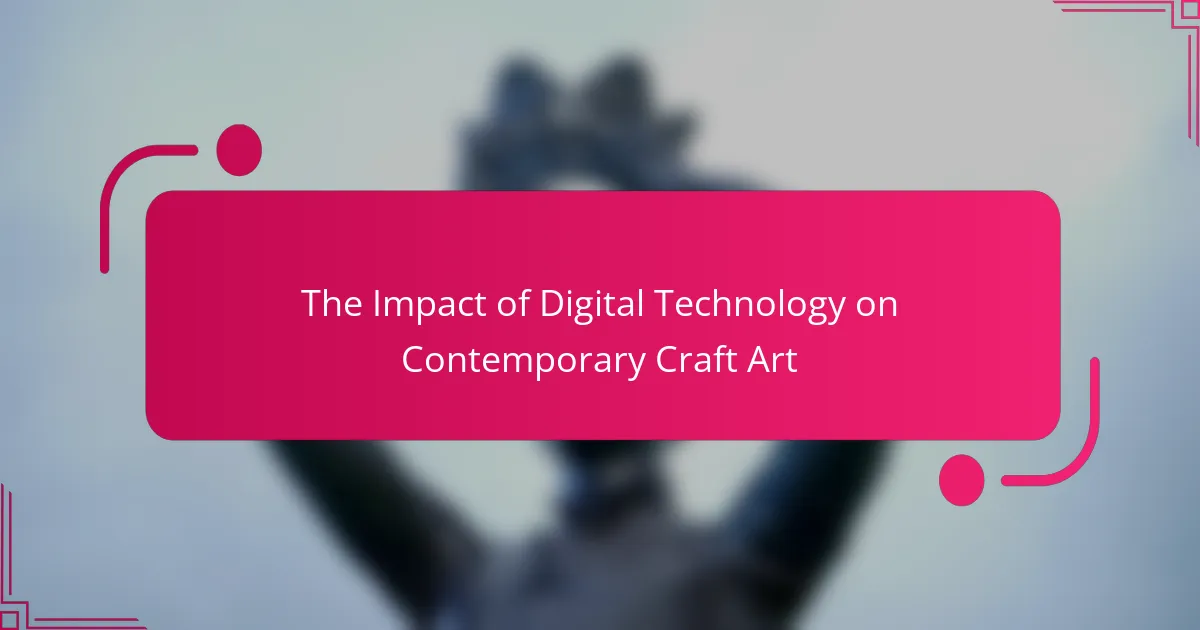Digital technology is transforming contemporary craft art by enhancing creativity, expanding market reach, and fostering collaboration. Artists leverage tools like 3D printing and online platforms to create intricate designs and showcase their work globally. However, challenges such as learning curves and equipment costs persist. Emerging trends like augmented reality and blockchain technology are redefining artistic expression and ownership in this evolving landscape.

How is Digital Technology Transforming Craft Art Practices?
Digital technology is revolutionising craft art practices by enhancing creativity and accessibility. Artists now utilise digital tools to expand their techniques and reach wider audiences.
Digital fabrication methods, such as 3D printing, allow artisans to create intricate designs that were previously impossible. This technology also enables artists to experiment with materials and forms, pushing the boundaries of traditional craft.
Furthermore, online platforms facilitate collaboration and sharing within the craft community. Artists can showcase their work globally, gaining exposure and feedback that enriches their practice.
Overall, the integration of digital technology in craft art not only transforms the creative process but also democratises access to art-making resources.
What Tools and Platforms Are Most Influential in Craft Art?
Digital technology significantly influences contemporary craft art through various tools and platforms. Key tools include 3D printing, which allows for intricate designs, and digital software like Adobe Illustrator for graphic design. Social media platforms like Instagram and Pinterest enable artists to showcase their work and connect with audiences globally. E-commerce sites like Etsy provide a marketplace for selling handcrafted items. Additionally, virtual reality can offer immersive experiences of craft art. Each of these tools enhances creativity, accessibility, and market reach for artists.
How Do Artists Integrate Digital Techniques with Traditional Methods?
Artists integrate digital techniques with traditional methods by blending innovation with craftsmanship. This fusion enhances creativity and expands artistic possibilities. For instance, digital tools allow for precise design and experimentation, while traditional methods provide texture and authenticity. The combination results in unique artworks that reflect both heritage and modernity. Many contemporary artists utilise software for initial design, then apply traditional techniques for final execution, creating a dialogue between the two mediums. This approach not only preserves traditional skills but also invites new interpretations and forms of expression in craft art.
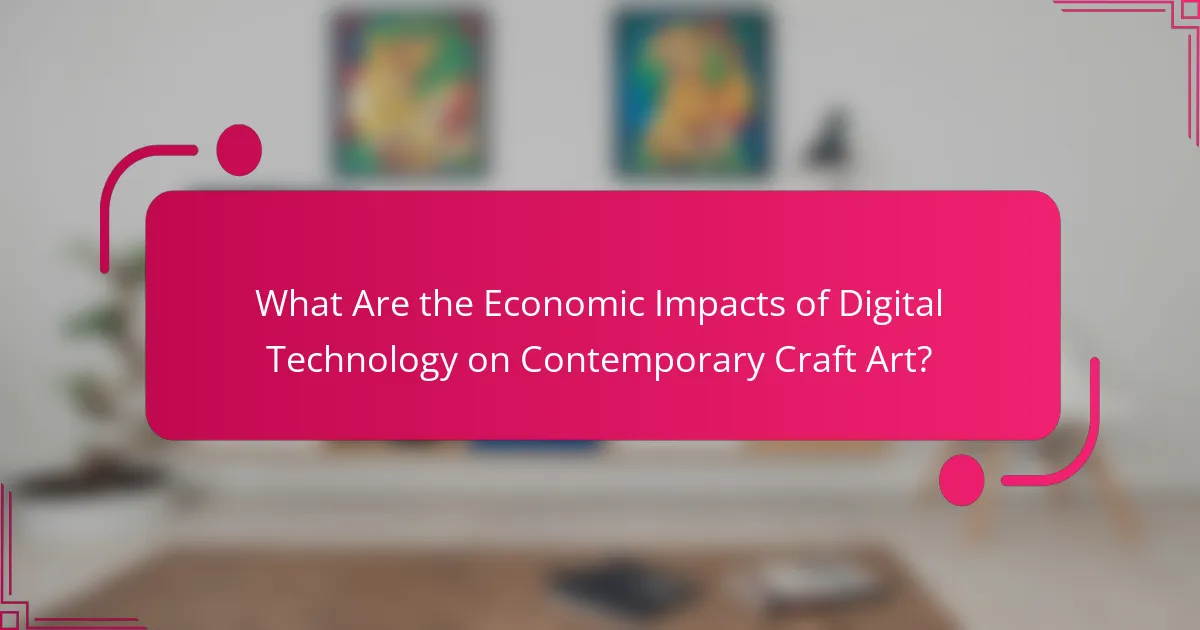
What Are the Economic Impacts of Digital Technology on Contemporary Craft Art?
Digital technology significantly enhances contemporary craft art by expanding market reach, improving production techniques, and fostering collaboration. Artists utilise online platforms for global exposure, allowing them to connect with diverse audiences. Advanced tools like 3D printing and digital fabrication streamline the creation process, enabling intricate designs that were previously unattainable. Moreover, digital technology encourages collaborative projects, merging traditional craftsmanship with innovative digital practices. This synergy not only enriches artistic expression but also drives economic growth within the craft sector.
How Do Online Marketplaces Affect Craft Art Sales?
Online marketplaces significantly enhance craft art sales by expanding reach and accessibility. They enable artisans to showcase their work to a global audience, increasing visibility. This digital platform allows for lower overhead costs compared to traditional retail, benefiting both sellers and buyers. Additionally, online marketplaces facilitate direct customer engagement, fostering community and loyalty among craft art enthusiasts. As a result, artisans can leverage data analytics to understand consumer preferences, refining their offerings accordingly.
What Role Do Social Media Platforms Play in Promoting Craft Artists?
Social media platforms significantly enhance the visibility and reach of craft artists. They provide a space for artists to showcase their work, engage with audiences, and connect with potential buyers. Platforms like Instagram and Pinterest allow for visual storytelling, making it easier for artists to share their creative processes and finished pieces.
Moreover, social media fosters community building among craft artists, enabling collaboration and support networks. Artists can join niche groups, participate in challenges, and gain inspiration from peers. This collaborative environment can lead to increased innovation and diversity in craft art.
The use of hashtags and targeted advertising on these platforms can also amplify an artist’s presence. By strategically utilising these tools, craft artists can reach specific demographics, driving sales and expanding their customer base. Overall, social media serves as a powerful tool for promoting craft artists in the digital age.

Which Educational Opportunities Are Available for Craft Artists in the Digital Age?
Craft artists have numerous educational opportunities in the digital age, including online courses, workshops, and virtual mentorship programmes. These platforms provide access to diverse techniques and global networks. Many institutions now offer specialised degrees focusing on digital craftsmanship, combining traditional skills with modern technology. Additionally, social media platforms serve as informal learning spaces, allowing artists to share knowledge and collaborate.
What Online Courses Are Most Beneficial for Skill Development?
Online courses focused on digital technology in craft art enhance skills in design, technique, and innovation. Courses like “Digital Fabrication for Artists” and “3D Modelling for Crafts” teach essential tools. These courses foster creativity and adaptability, crucial in contemporary art. As a result, participants gain a competitive edge in the evolving art landscape.
How Can Workshops Leverage Digital Technology for Enhanced Learning?
Workshops can leverage digital technology by integrating interactive tools and platforms that enhance participant engagement. These technologies facilitate real-time feedback and collaboration among attendees. For instance, virtual reality can immerse participants in craft art techniques, while online forums can foster community discussions. Additionally, analytics tools can track learning outcomes, enabling facilitators to tailor content effectively. This approach maximises the impact of contemporary craft art education through innovative digital solutions.

What Challenges Do Craft Artists Face When Adopting Digital Technology?
Craft artists face several challenges when adopting digital technology, including learning curves, equipment costs, and maintaining artistic integrity. The transition to digital tools often requires significant time investment for skill development. Additionally, the initial financial outlay for software and hardware can be substantial. Artists may also struggle with balancing traditional techniques and digital methods, which can affect their unique style. Lastly, the rapid pace of technological advancement can lead to ongoing adaptation challenges.
How Can Artists Overcome Technical Barriers in Digital Crafting?
Artists can overcome technical barriers in digital crafting by embracing continuous learning and utilising accessible tools. Adopting online courses and tutorials enhances skills in software and techniques. Collaborating with other artists fosters knowledge sharing and innovation. Engaging with digital art communities provides support and resources. Experimenting with various digital mediums allows artists to discover unique styles. Investing time in practice builds confidence and proficiency, ultimately enhancing creative expression.
What Are Common Misconceptions About Digital Craft Art?
Common misconceptions about digital craft art include the belief that it lacks authenticity and that it diminishes traditional techniques. Many assume digital tools replace creativity, but they often enhance it. Digital craft art can blend traditional methods with modern technology, creating unique works. Additionally, some think digital art is less valuable, yet it can command high prices in galleries and online platforms.
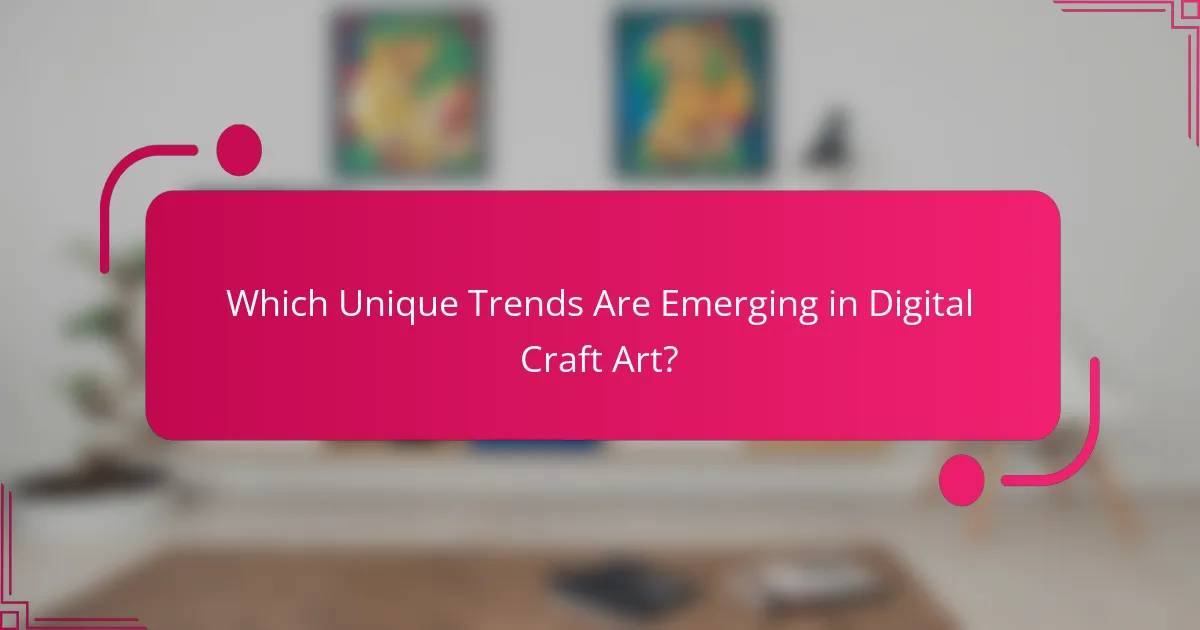
Which Unique Trends Are Emerging in Digital Craft Art?
Emerging trends in digital craft art include the integration of augmented reality, 3D printing, and blockchain technology. These innovations enhance artistic expression and redefine ownership. For instance, augmented reality allows artists to create interactive installations, while 3D printing enables complex designs that were previously impossible. Blockchain technology introduces secure provenance tracking for digital artworks, ensuring authenticity and value. As a result, digital craft art is evolving into a dynamic field that combines creativity with cutting-edge technology.
How Are Augmented and Virtual Reality Being Used in Craft Art?
Augmented and virtual reality are transforming craft art by providing immersive experiences and innovative techniques. Artists use these technologies to create interactive installations, allowing viewers to engage with art in new ways. For instance, virtual reality enables the simulation of crafting processes, giving users a sense of creation without physical materials. Augmented reality enhances traditional craft by overlaying digital elements onto real-world objects, enriching the storytelling aspect of the art. This integration of digital technology not only expands creative possibilities but also attracts a broader audience.
What Innovations Are Driving the Future of Craft Art?
Digital technology is revolutionising contemporary craft art by enhancing creativity and accessibility. Innovations such as 3D printing and digital design software enable artisans to experiment with new forms and materials. These technologies lower production costs and allow for rapid prototyping, fostering a culture of experimentation. Additionally, online platforms provide broader market access, connecting artists with global audiences. As a result, digital technology is creating a more inclusive and dynamic craft art landscape.
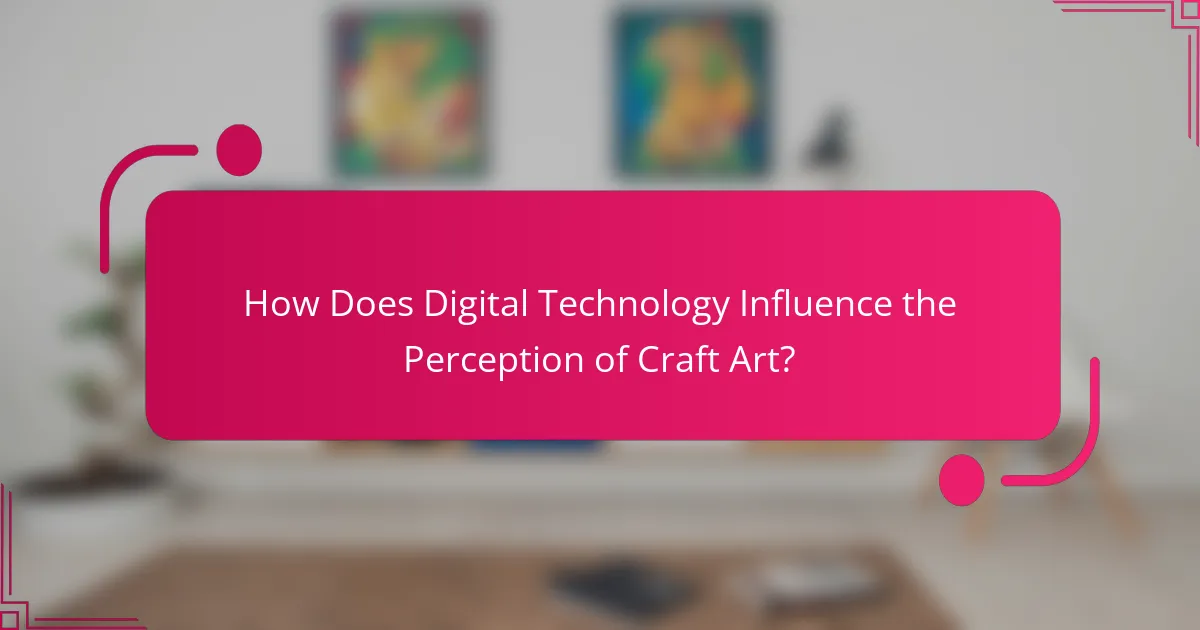
How Does Digital Technology Influence the Perception of Craft Art?
Digital technology significantly enhances the perception of craft art by making it more accessible and visible. Online platforms allow artists to showcase their work globally, reaching diverse audiences. Virtual reality and augmented reality enable immersive experiences, transforming how craft art is experienced. Social media fosters community engagement, allowing artists to interact directly with their audience. Additionally, digital tools streamline the creation process, offering new techniques and materials that expand artistic possibilities. These advancements collectively reshape the contemporary craft art landscape, emphasising innovation and connectivity.
What Are the Cultural Implications of Blending Digital and Traditional Craft?
Blending digital and traditional craft fosters innovation while preserving cultural heritage. This integration enhances accessibility and promotes collaboration among artists. Digital tools enable new forms of expression, allowing craftspeople to experiment with techniques and materials. As a result, this fusion can lead to a revitalisation of traditional crafts, attracting younger audiences and ensuring their continuity. Additionally, digital platforms facilitate the sharing of knowledge and skills, creating a global community that values diverse cultural practices.
How Do Different Regions Perceive Digital Craft Art?
Different regions perceive digital craft art through distinct cultural lenses and technological access. In urban areas, digital craft art often embraces innovation and experimentation, reflecting contemporary trends. Conversely, rural regions may focus on preserving traditional techniques while integrating digital elements, resulting in unique hybrid forms.
For instance, in North America, artists leverage social media platforms to showcase their work, enhancing visibility and engagement. In contrast, European artists often emphasise sustainability in digital craft, using eco-friendly materials and practices.
Additionally, regions with advanced technology infrastructure, like East Asia, witness a rapid evolution of digital craft art, characterised by collaborations between artists and tech companies. In less developed areas, access to digital tools can be limited, affecting the growth and perception of digital craft art.
Overall, regional differences highlight the dynamic interaction between culture, technology, and art, shaping how digital craft is created and appreciated.
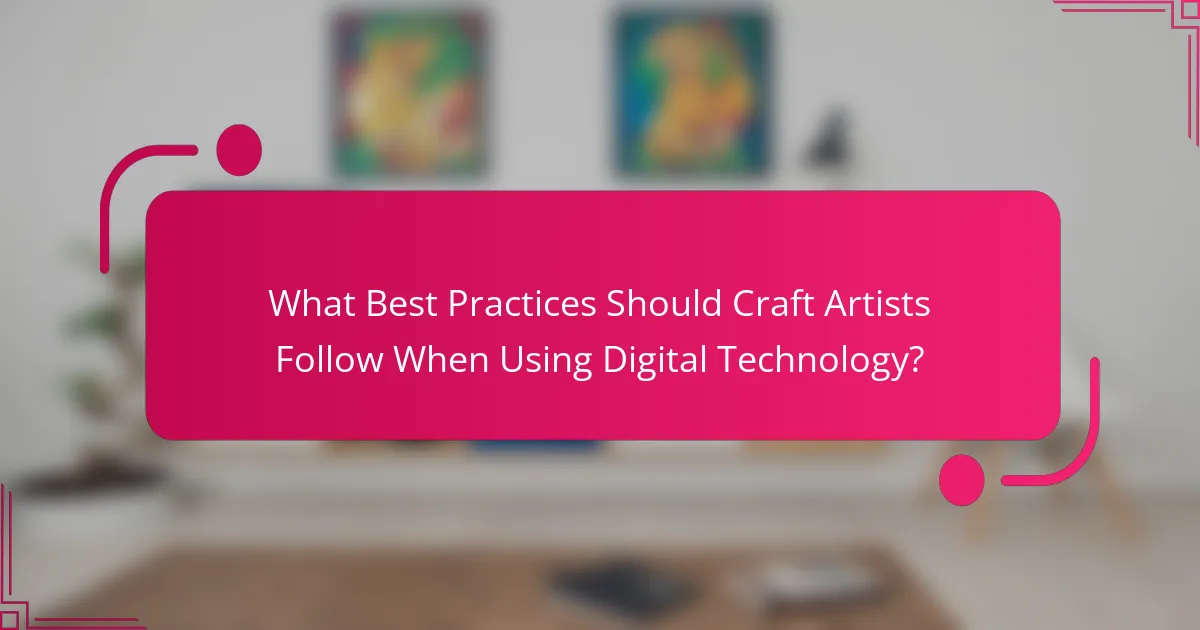
What Best Practices Should Craft Artists Follow When Using Digital Technology?
Craft artists should prioritise adaptability, skill development, and collaboration when using digital technology. Embracing new tools enhances creativity and efficiency.
1. Stay updated with software advancements to leverage new features.
2. Invest time in learning digital techniques to expand artistic capabilities.
3. Collaborate with technologists to integrate innovative solutions into craft processes.
4. Experiment with digital platforms to reach wider audiences and markets.
How Can Artists Effectively Market Their Digital Craft Creations?
Artists can effectively market their digital craft creations by leveraging social media, online marketplaces, and digital storytelling. Engaging with audiences through platforms like Instagram and Pinterest showcases work visually and builds community. Utilising platforms such as Etsy or Shopify provides a dedicated space for sales, enhancing visibility. Digital storytelling through blogs or videos can create emotional connections, highlighting the creative process and the story behind each piece. Collaborating with influencers or participating in online art events can further amplify reach. Consistent branding and a clear online presence are essential for attracting and retaining customers.
What Are Key Considerations for Ensuring Quality in Digital Craft Art?
Key considerations for ensuring quality in digital craft art include mastering technology, understanding digital tools, and maintaining artistic integrity. Artists must balance innovation with traditional techniques to create meaningful work. Quality is also determined by the attention to detail in digital execution and the emotional connection of the piece. Engaging with the audience through interactive elements can enhance the overall experience, making the art more impactful.
